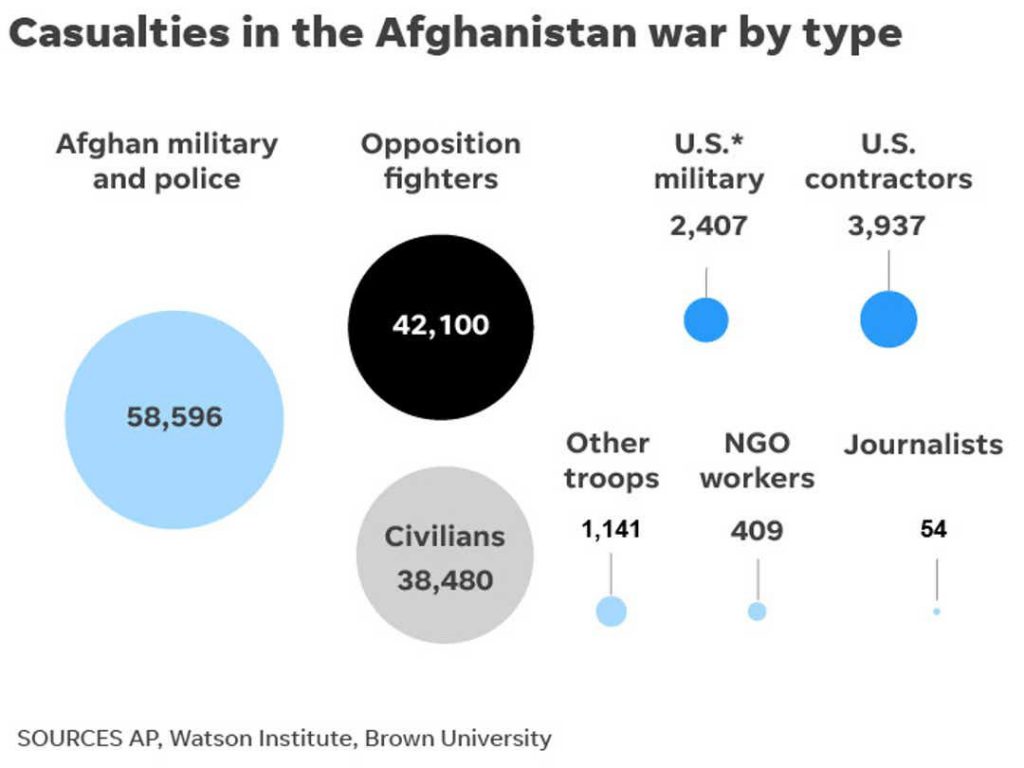Bombs, missiles falling at record pace in long-running Afghanistan war
As American ground forces in Afghanistan shrink, U.S. and allied warplanes are dropping bombs and firing missiles at insurgent targets at a record pace in the 18-year-long war.
The spike in firepower coincides with a Trump administration policy, dating to 2016, that gives military commanders greater authority to attack Taliban and Islamic State militants in Afghanistan.
“The logic is that the Taliban may be more likely to agree to a peace deal acceptable to the United States and the Afghan government if the Taliban believe they can’t win the war in Afghanistan,” said Seth Jones, a defense analyst at the Center for Strategic and International Studies and former adviser to the special operations commander in Afghanistan.
“Consequently, airstrikes and ground operations are a way to raise the costs for the Taliban of continuing to fight,” he said.
But negotiations with insurgents have broken off.
August 2019: Trump says US will maintain 8,600 troops in Afghanistan after major withdrawal
From Jan. 1 through October, U.S.-led forces have used 6,208 missiles and bombs in Afghanistan. That compares with 5,982 for the same period in 2018, which saw the most airstrikes of any year since the Taliban was toppled in 2001.
Fewer ground forces, more airstrikes
Trump has pushed for a smaller U.S. troop presence in Afghanistan, a reduction to 8,600, one of the lowest points in the history of the war. In 2011, the number of U.S. troops swelled to nearly 100,000 and dipped to 8,300 in 2017.
It’s unclear whether the increased reliance on air power will work, Jones said. “The Taliban does not appear to be coerced and still believes it can win on the battlefield,” he said. “In fact, the Taliban appears to be emboldened with U.S. policymakers, including President Trump, who have publicly noted a desire to get the U.S. out of Afghanistan and stop the ‘endless wars.’ “
Trump suspended peace talks in September after the Taliban claimed credit for an attack in Kabul that killed a U.S. soldier.
The increase in bombing stems from the need to support the operations of Afghan security forces against the Taliban and other extremist groups and to defend against their attacks on Afghan society, said Army Maj. Beth Riordan, a spokeswoman for U.S. Central Command, which oversees military operations in Afghanistan.
“All of our operations in Afghanistan support our mission to assist the Afghan government and its security forces’ effort to maintain security and stability in the country and prevent the country from becoming a safe haven for terrorism,” Riordan said.
In 2016, Pentagon officials gave greater authority to the commander in Afghanistan to unleash more airstrikes. That change followed a resurgence in Taliban activity.
At the time, Pentagon officials said increased bombing could trigger “catastrophic success” in support of Afghan troops. Bombing runs increased that year and more than tripled in 2017.
Afghan civilians at risk
More bombing means greater risk for civilians. An airstrike on several drug labs in May killed or wounded 39 civilians, including 17 working in the labs, according to a U.N. investigation. The United Nations also cited “reliable” reports of an additional 37 civilians killed or wounded in the raids, most of them women and children. The U.S. command in Kabul disputed the findings, saying those killed were Taliban operatives.
“Preventing civilian casualties remains a top priority for U.S. forces in Afghanistan and our allies and partners,” Riordan said. “Our forces support the Afghan government’s efforts to protect its civilian population, and we take extraordinary measures to minimize and mitigate civilian casualties, and further, to investigate all reports of civilian casualties.”
The longest war in U.S. history has claimed the lives of more than 2,400 U.S. troops and tens of thousands of Afghan civilians, security forces and Taliban militants. It has cost U.S. taxpayers more than $750 billion.

